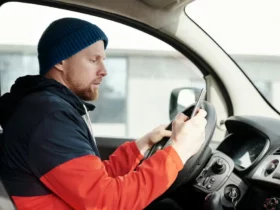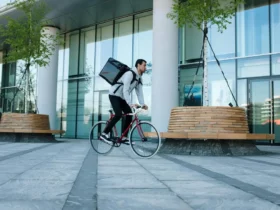Ever found yourself suddenly unable to log into your Grubhub for Drivers app? It’s a real bummer, especially when you’re all geared up to earn some cash. But don’t worry, you’re not alone. Drivers can get deactivated for a few reasons, like not accepting enough orders or being inactive for too long.
Navigating the Challenges: What Happens When a Grubhub Driver Gets Deactivated
Insights into Deactivation Causes
Understanding why my Grubhub driver account might get deactivated digs right into the heart of the service’s quality control mechanisms. Deactivation isn’t just some random stroke of bad luck; it’s directly tied to how well I’m performing on the platform. If my acceptance rate dips too low or if I’ve let too many orders go by, Grubhub sees that as slacking on the job. They need drivers who are responsive because that’s what keeps customers satisfied and the system running smoothly.
Moreover, I’ve learned that if I haven’t accepted any deliveries in an extended period, typically around 90 days, the system might flag my account as inactive. This is a clear sign to me that consistency is crucial. To keep myself in check, I regularly check my app for activity. Timeliness is another big factor – late deliveries lead to unhappy customers, and Grubhub wants none of that. Keeping an eye on the clock and ensuring I’m efficient in my routes is a non-negotiable part of the job.
However, it’s more than just logistics. My overall Rating plays a significant role. Ratings matter because they reflect the quality of service – think of them as a report card for how well I’m doing. Poor customer service or any kind of lapse in maintaining a customer’s order can land me in hot water too. This tells me that every interaction counts, every delivery is a performance, and maintaining a positive can-do attitude is as important as delivering the food itself to avoid deactivation.
Navigating Reactivation: A Step-by-Step Guide
So, I’ve been deactivated. What’s next? There’s a clear path to getting back on the road. The key is to approach the reactivation process with diligence and patience. The first move is to Contact Customer Care. They’re the ones who can give me the lowdown on what exactly led to my account being deactivated and how I can address the issue.
Once I’m in touch with customer support, I’d need to submit a formal request to re-activate my account. This entails going through the appropriate channels, and yes, this feels similar to applying all over again. The process goes something like this:
- Log in to my Grubhub driver account.
- Navigate to the reactivation request portal.
- Input the necessary details like my email, phone number, and name – the basics they need to identify my account.
- Honestly, detail why I believe my deactivation might have been an error or why I deserve a second chance.
It’s crucial not to neglect the documentation. Being thorough here can make a big difference. Up-to-date Documents like my driver’s license and proof of insurance should be ready to upload. The last step is waiting to hear back from Grubhub – this can be the most nerve-wracking part, but it’s important to remain optimistic and prepared to jump back into action.
Common Reasons for Grubhub Driver Deactivation
Non-compliance with Grubhub’s Policies and Guidelines
I’ve noticed that the rigidity of Grubhub’s policies often leaves little room for error for drivers. One primary reason drivers find their accounts deactivated is due to non-compliance with the company’s policies and guidelines. These are extensive and cover a wide array of do’s and don’ts that I, as a driver, need to adhere to. Anything from the way I communicate with customers and restaurants to maintaining a professional demeanor falls under their scrutiny.
Grubhub’s extensive Terms of Use outline specific behaviors that could lead to an account deactivation, including actions deemed unsafe, unprofessional, or that violate privacy or harassment policies. What many drivers might not realize is that these terms also prohibit the use of the driver app in ways intended to disrupt its functionality. Whether it’s communicating in inappropriate ways or failing to complete deliveries, it’s clear that Grubhub takes these standards seriously.
Repeated Late Deliveries or Excessive Order Cancellations
Timeliness is a cornerstone of the delivery industry, and Grubhub is no exception to this rule. If I’m consistently delivering orders late, it won’t be long before my account is flagged for review. Repeated late deliveries are a significant infraction because they directly affect customer satisfaction. Just as damaging are excessive order cancellations. This not only disrupts the flow of deliveries but also adds to the late delivery count – a double whammy of sorts.
Grubhub sets minimum standards for order acceptance and completion, and falling short of these can lead to deactivation. It’s not just about accepting orders. I also need to follow through and make sure those deliveries are punctual. Deactivations for such reasons impact not just my record but also the company’s relationship with its customers.
Providing Incorrect Information or Fraudulent Activities
One of the most severe breaches involves providing incorrect information or partaking in fraudulent activities. I understand that integrity is key, and any deviation, such as claiming to have completed a delivery without actually doing so, sets the stage for immediate deactivation. Grubhub also prohibits the use of multiple driver accounts, faking GPS locations, and any form of tampering with orders.
Not only does this breach the trust of the platform, but it jeopardizes the safety and satisfaction of customers, which Grubhub prioritizes above all. I’ve heard of cases where accounts were deactivated under the suspicion of fraud as a blanket term for a variety of policy violations. It’s always best to play it straight; attempting any underhanded tactics to game the system is a surefire way to get booted off the platform. Grubhub’s new three-strikes policy underscores their commitment to enforcing these rules, and as a driver, I’ve got to keep on the straight and narrow to ensure my account remains in good standing.
Impact of Poor Customer Reviews
Customer reviews can be the linchpin in maintaining a good standing as a Grubhub driver. While direct penalties for declined orders or canceled shifts exist, feedback from customers plays a significant role. They hold the power to influence perceptions and impact a driver’s reputation on the platform.
The Role of Customer Feedback in Driver Account Standing
Customer feedback is the backbone of the service industry, and for Grubhub drivers, it’s no different. Without a star rating system like some other platforms, Grubhub utilizes customer feedback in a unique way. Customers express their satisfaction with a simple thumbs-up or thumbs-down, but it’s the serious complaints that catch the company’s attention.
When a customer calls or writes in with a complaint, it could signal trouble for the driver involved. Negative reviews, particularly those that report unsafe or unprofessional practices, can lead to immediate deactivation. Instances cited by customers can range from a driver’s demeanor to the accuracy and timeliness of deliveries.
I’ve learned it’s not just the number of negative reviews but the severity and nature of the complaints that matter. A pattern of such feedback can paint a picture of unreliability or unprofessionalism, and that’s when Grubhub may step in. This system underscores the importance of providing exceptional service with each delivery and maintaining clear communication with both the restaurants and customers.
Acceptance rates also factor into the mix. According to what I’ve pieced together, Grubhub calculates a driver’s acceptance rate by the number of orders accepted versus the total number of orders received. If this rate slips below 75%, it could trigger a review of the driver’s account.
In understanding the significance of customer feedback, it’s clear that a proactive approach is necessary. Planning routes efficiently to reduce cancellations, communicating effectively with customers and restaurants, and handling disputes with poise can help avoid the pitfalls of negative reviews. Balancing the need to maintain a decent acceptance rate with the pursuit of higher-paying orders adds another layer to this delicate ecosystem.
Grubhub’s system is designed for drivers to manage their availability and accept or reject orders through the Driver App. This level of autonomy means the responsibility falls squarely on my shoulders to manage these elements effectively. And even though I have the freedom to rate and review restaurants through the app, these interactions can have reciprocal effects, highlighting the interconnectedness of the entire delivery experience.
Preventive Measures for Grubhub Drivers
Maintaining Good Standing as a Grubhub Driver
To remain a Grubhub driver, it’s essential to stay in good standing with the platform. That means understanding and adhering to Grubhub’s expectations for delivery partners. I make sure to never falsely claim I’ve delivered an order and always strive to complete the orders I accept. On top of that, I need to be professional and safe in all my interactions — both on the road and with customers or restaurant staff. This is particularly important as repeated complaints or serious allegations of unprofessional behavior can tarnish my reputation and are grounds for deactivation.
I keep in mind that providing high-quality service is not just about avoiding complaints; it’s about exceeding expectations. I aim to deliver every order on time, keep food in excellent condition, and ensure I project a positive image of Grubhub. Staying informed about industry standards in my region also helps me meet or surpass the service quality Grubhub expects from me.
Strategies to Avoid Common Pitfalls Leading to Deactivation
I’ve developed several strategies to avoid the common issues that can lead to an account deactivation. Here’s what I find vital:
- Read and Understand the Terms of Service: It’s crucial that I fully understand the terms I agreed to. I make it a habit to regularly review Grubhub’s policies to keep up with any changes.
- Effective Communication: If I’m uncertain how to handle a particular situation, like a traffic accident, I don’t hesitate to communicate with the support team for guidance to prevent any violations.
- Document Everything: Keeping a detailed record of my deliveries, including times, dates, and any relevant communications with customers or restaurants, helps safeguard my account against misunderstandings or false claims.
By following these and other proactive measures, I’m not just trying to avoid deactivation; I’m also aiming to provide an exceptional service that will keep customers and restaurants satisfied.
Importance of Adhering to Grubhub’s Operational Standards
Adhering to Grubhub’s operational standards is not merely about compliance; it impacts my ability to offer top-notch service and maintain my income stream. Grubhub’s guidelines aren’t arbitrary; they’re structured to foster a safe and reliable environment for everyone involved.
Ensuring that I never act in a harmful or threatening manner, avoiding any involvement in illegal activities, and respecting intellectual property rights are all part of maintaining a professional standard. I’m cautious never to engage in communication that could be perceived as misleading or done in bad faith.
Above all, I know my behavior as a Grubhub driver has a direct effect on the brand’s reputation. That’s why I go the extra mile to follow Grubhub’s guidelines and uphold the quality of service customers and restaurants expect. By doing so, I help to create a positive and sustainable ecosystem for all users of the platform.
Best Practices for Customer Interactions and Deliveries
One of the key aspects of being a successful Grubhub driver is to understand and master the art of timely deliveries. A positive customer experience often hinges on this crucial point, and you don’t want a Grubhub delivery to be paused for any reason. As a driver, it’s imperative to plan my route efficiently and always stay aware of typical traffic patterns. Data shows that the average food delivery time is around 35 minutes. Although there may be occasional hiccups, striving to meet or beat this benchmark consistently is vital for maintaining good customer relations and safeguarding against deactivation.
- Monitor traffic and adjust routes accordingly.
- Leave early to accommodate for possible delays.
- Always confirm order details to avoid mix-ups which can lead to delays.
By keeping delivery times short, I fulfill one of the top needs of both the customers and the delivery platforms. The customers expect their orders to not just arrive quickly but also hot and fresh. The platforms, on the other hand, rely on drivers to uphold their service standard promises.
Additionally, the manner in which deliveries are made has a direct impact on customer satisfaction. If a customer has special instructions, I make sure to follow them to the letter. This could mean placing their bags in front of their door if they’ve requested contactless delivery or making sure to handle their food with care and present it neatly upon arrival. Documenting these steps with photos can not only reassure the customer but also act as evidence in case of complaints.
While effectively managing deliveries is crucial, so is maintaining a polite and professional demeanor, even if the customer has a less-than-pleasant attitude. As frustrating as it can be, it’s important to remember that patience and kindness can go a long way in diffusing difficult situations. Not every interaction will be perfect, but how I adapt and respond can leave a lasting impression – and could be the difference between a repeat customer and a one-time transaction.
Exploring Alternatives After Grubhub Deactivation
Alternative Platforms and Opportunities for Gig Drivers
After a setback like being deactivated from Grubhub, I’m keen on exploring other platforms where I can put my delivery skills to use. There’s a bevy of gig economy apps that beckon my attention. For instance, I’m looking at DoorDash, Uber Eats, and Postmates, to name a few. These platforms are always on the lookout for drivers, so they’re potential goldmines where I can get back in the driver’s seat.
When I compare Grubhub to other gig platforms, I notice several differences, especially when it comes to flexibility and driver requirements. Uber Eats often allows for more spontaneous log-ins where I can hop on the app and start taking orders immediately. DoorDash seems to have a similar level of flexibility, offering a Dash Now option that is perfect for fitting work around my schedule.
The driver requirements across these platforms also vary. Some may have more stringent vehicle requirements or different insurance standards. For instance, the vehicle age for Uber Eats might differ from what Grubhub demands. These little details matter because they can affect my eligibility and the type of work I can pursue.
One thing I’ve noticed is that the deactivation policies can also vary quite a bit. While Grubhub may deactivate drivers without much explanation, other platforms might operate with a more transparent process. It’s about weighing which platform aligns with my preferences for flexibility, potential earning, and fair treatment.
Seeking Support and Resources for Deactivated Drivers
Resources and Support for Reactivation and Beyond
Getting back on the road after deactivation is my top priority, and I’m sure it’s yours too. It’s essential to know where to look for help and how to utilize available resources effectively. I’ll walk you through some steps and point you toward support networks that can make a real difference.
Contacting Customer Support is often the first step after a deactivation. It’s critical to approach this calmly and professionally, no matter how frustrated I might feel. I’ve found it useful to have all my information ready and to document every interaction. If reactivation is denied without explanation or seems unfairly handled, I don’t hesitate to escalate my inquiry to a higher level within the company.
In cases where drivers feel they’ve been wronged, Legal Resources can be invaluable. Many online communities and driver advocacy groups offer guidance on potential legal recourse, especially in instances where deactivation may have stemmed from discriminatory practices. I always remind myself that knowledge is power, so I stay informed about my rights as an independent contractor.
Networking with other drivers through Online Forums and Social Media Groups has also been helpful. These spaces are where I can share experiences, receive tips on dealing with deactivation, and find out about any systemic issues that might be affecting others like me. Solidarity can sometimes lead to collective solutions, or at least provide moral support.
Diversification of Gig Platforms is another strategy I’ve picked up on. Registering with multiple services not only broadens my income sources but also provides a fallback if I’m temporarily sidelined from one. Plus, the experience gained from various platforms has honed my skills and made me a more adaptable driver.
Lastly, some drivers might consider seeking Mentoring or Professional Advice. Experienced drivers often have a wealth of knowledge about navigating the specifics of reactivation and maintaining good standing with these platforms. Their insights can be incredibly beneficial, and I’ve learned so much from the seasoned pros willing to share their expertise.
While these resources and support systems are crucial, they’re not the only factors in successfully managing and overcoming a deactivation. I continue to explore other avenues and stay vigilant, ensuring I’m prepared for any hurdles that might come my way in my journey as a gig economy driver.
Conclusion
Navigating the complexities of Grubhub driver deactivation involves understanding the reasons behind it, such as non-compliance with policies, late deliveries, or fraudulent activities. Reactivating your account requires a systematic approach, involving contacting customer support, providing necessary documents, and being patient during the review process.
This experience underscores the importance of maintaining good standing through adherence to Grubhub’s standards and effective customer interactions. For those facing deactivation, exploring alternative platforms and utilizing available support resources can offer pathways to continue in the gig economy.
FAQ – Frequently Asked Questions
Does Grubhub provide specific feedback on why a driver was deactivated?
Grubhub may provide general reasons for deactivation but may not always disclose detailed specifics due to privacy and policy reasons.
How long does it typically take for Grubhub to review and respond to a reactivation request?
The review process time can vary, but drivers generally receive a response within a few days to a couple of weeks.













